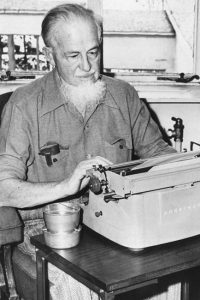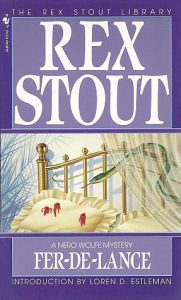
Rex Stout working at his typewriter.
Fer- De- Lance by Rex Stout, published in 1934 by Farrar & Reinhart, seamlessly ties the ideas of both an armchair and hardboiled detective into one novel. Readers are placed in New York City in the hustle and bustle of the early 20th century, with a that plot revolves around Nero Wolfe, an armchair detective who has a mad obsession over his orchids and work. A reader also meets Archie Goodwin, who uses a more aggressive, “manly” force to get details of the suspects to help Wolfe solve the case. From Archie’s perspective, the audience will follow the case through three different murders, noting how each murder is connected. Wolfe follows a trail of clues, and eventually finds the man he was sent to find. Only to find him dead. This is the first novel in a trail of mysteries that will define the series of Nero Wolfe through his eccentric ways of detecting.
Wolfe, since he is an armchair detective, does not leave his house. All of the investigation is done by his partner, Goodwin, and analyzed by Wolfe. The peculiar part about the body that Wolfe was sent to find was a newspaper that was found in the mans pocket that focused on the death that happened a few days earlier; the mysterious murder of Peter Oliver, a president of a college. Who Archie discovers to be very loved- therefore not the typical murder victim. This is when the genius of Nero Wolfe kicks in, somehow while looking at his flowers and sitting in his bed just to think, he figures out that both murders are connected. Wolfe has to figure out how a college president and an immigrant connect together, and why one mysteriously died on a golf course, while the other is left murdered in the woods. Wolfe, with the help of his bad-ass, knowledgeable side kick Goodwin is able to solve the case and let his morality still thrive.
The most impactful portion of Fer- De- Lance is what the book did for the detective and mystery fiction tradition. Stout integrated an eccentric armchair detective with a moody hard-boiled detective and forced them to work together as partners. This created an interesting balance for the audience because different emotions were brought out of the characters that would not have been present in their own genre. Goodwin is a key example for this. Usually hard-boiled detectives are assumed to be cross, super- sexist, moral, and most of the time angry. While all of these traits are present in Goodwin’s character, new ideas like empathy and a huge sense of respect is shown through Goodwin. Wolfe spends, on a usual day, four hours with his plants just watering and thinking. Goodwin knows that this is Wolfe’s quiet time and that he will not disturb him unless it is a dire emergency. Even when an emergency arises, Goodwin stands on the stairs of the greenroom debating whether or not to disturb him. This idea of having a respectful hardboiled detective is new and something that authors of hardboiled stories, like Raymond Chandler who focus only on solving the case through manipulating or violence, would never do. Since both characters are from a different sub-genre of mystery fiction and then are being forced together into one book, a different form of detective emerges from the pages- making Nero Wolfe mysteries a successful series and market. Nero Wolfe mysteries became so popular that a movie, Meet Nero Wolfe, was produced in 1936 and a TV show, Nero Wolfe, was produced in 2000.¹
Yet, the book overall is not that memorable. Readers will connect or find entertainment in certain parts of the book, but overall the book drags you along for the mystery instead of engaging its audience. What keeps the reader entertained is that the story is told from the perspective of the funny sidekick. Reader’s must completely trust Goodwin to engage in the novel. Which is not a hard task since Wolfe is loyal to Goodwin and trusts his work.³ Also, watching from Goodwin’s perspective, the way that he perceives Wolfe is worth a read.
“I spread open a first section on the desk before him and he pulled himself up in his chair to hunch over it. It was like seeing a hippopotamus in the zoo get up for a feed.” (21)
The reader often finds themselves just pushing through to continue the book. I think this happens to a fault because of Wolfe’s characterization. A huge part of Nero Wolfe is that he “relapses” into a state of depression and completely is disinterested in the mystery. The slowing of the pace, determined by Wolfe’s mental state, is agitating to a reader. Slowing the mystery stops the attention of the reader, lessoning interest. Another reason to fault for its lack of excitement is that the plot is not new and innovative. Towards the end of the novel the plot plays out much like the audience will guess it does. The issue with Fer-De-Lance is the only thing new and innovative is how these characters from very different sub-genres interact with each other.
However, it is refreshing to see how the genre changes throughout the book. Towards the end, after the murderer is quickly introduced, the novel shifts from a hard-boiled/armchair detective story to a state of psychological suspense. Although, you are not let into the murderer’s mind, and explained the motives until the very end. This is the fault on not having a third person narrator, when the main detective chooses to hide the ending of the crime from the sidekick than subsequently he hides the ending from the reader until he feels that it is time to tell the reader. To be so engrossed in the plot and then just be completely taken out of it, until the last few pages, not only causes the reader to lose interest but causes annoyance.
Final Verdict: 
Overall, just because Fer-De-Lance did not appeal to my logical or emotional being does not mean that it is a bad book. Rex Stout is a very thorough author who brought his reader into the book that he was setting up. He set up the characters not only to fit in their own subgenre but come together to create a new branch of another one. Not once did the story lack a detail that made it un-comprehendible or an underdeveloped character. Plainly, it just lacked an exciting, new plot that keeps a reader intrigued. Overall, I rate Fer-De-Lance by Rex Stout two stars out of a five, for satisfactory writing and characterization but under- developed plot leading to a quick ending.
References and Other Resources:
- “Meet Nero Wolfe.” IMDb, http://www.imdb.com/title/tt0027952/. Accessed on 28 Nov. 2017.
- Stout, Rex. Fer De Lance. Farrar & Reinhart, 1934.
- Streufert, Paul D. “Nero Wolfe.” Student’s Encyclopedia of American Literary Characters, Facts On File, 2008. Bloom’s Literature, online.infobase.com/HRC/Search/Details/95006. Accessed 28 Nov. 2017.
- “The League of Frightened Men 1937 – Walter Connolly as Nero Wolfe, Irene Hervey – book by Rex Stout” uploaded by filmnoir2019, 19 April 2016, https://www.youtube.com/watch?v=w2RdUop4FSU&t=81s.
- “About Rex Stout, Author, Business Man, Sailor, Activist, Family Man, & a person with many interests.” The Wolfe Pack, http://www.nerowolfe.org/htm/stout/. Accessed 28 Nov. 2017.
To purchase Fer De Lance by Rex Stout click below,
https://www.amazon.com/Fer-Lance-Nero-Wolfe-Stout/dp/0553278193

